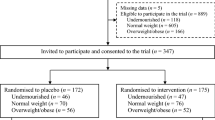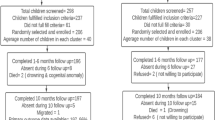Abstract
Background/Objectives:
Multiple micronutrient supplementation with Sprinkles powder and crushable Foodlets tablets may be effective means of controlling micronutrient deficiencies in infants. Their efficacy has not been tested in countries like Iran where wheat as the staple food may affect nutrient bioavailability. This study aimed to compare the efficacy of Sprinkles, Foodlets and the current supplement (Drops) for improving micronutrient status and growth among Iranian infants.
Subjects/Methods:
Infants of 6–18 months of age, living in an urban district of Iran were randomised to receive daily Sprinkles (n=120), Foodlets (n=121) or Drops (n=121) for 4 months. Haemoglobin (Hb), serum ferritin, serum retinol, serum zinc, 25(OH) D concentration and anthropometry were assessed at baseline and at 4 months.
Results:
Iron status improved with all treatments. Drops showed significantly greater changes in Hb and serum ferritin, though changes in anaemia prevalence were not different across groups. Infants having Foodlets and Sprinkles had significantly greater reductions in proportion of children with zinc deficiency compared with Drops. No significant differences in treatment effects were observed for mean serum 25(OH) D and retinol, or for growth of infants across groups.
Conclusion:
The study was the first efficacy trial with Sprinkles and Foodlets in the Middle East where wheat or rice is the principal complementary foods. Differences across treatment groups were largely consistent with supplement micronutrient composition for iron and zinc, with no benefit in this population for serum retinol, 25(OH) D, growth or anthropometric status. The trial identified trade-offs in combining multiple micronutrients in a single delivery mechanism.
This is a preview of subscription content, access via your institution
Access options
Subscribe to this journal
Receive 12 print issues and online access
$259.00 per year
only $21.58 per issue
Buy this article
- Purchase on Springer Link
- Instant access to full article PDF
Prices may be subject to local taxes which are calculated during checkout

Similar content being viewed by others
References
Allen LH, Shrimpton R (2005). The International Research on Infant Supplementation study: implications for programs and further research. J Nutr 135, 666S–669S.
Brown KH, Peerson JM, Rivera J, Allen LH (2002). Effect of supplemental zinc on the growth and serum zinc concentrations of prepubertal children: a meta-analysis of randomized controlled trials. Am J Clin Nutr 75, 1062–1071.
Brown KH, Wessells KR, Hess SY (2007). Zinc bioavailability from zinc-fortified foods. Int J Vitam Nutr Res 77, 174–181.
Christofides A, Asante KP, Schauer C, Sharieff W, Owusu-Agyei S, Zlotkin S (2006). Multi-micronutrient Sprinkles including a low dose of iron provided as microencapsulated ferrous fumarate improves haematologic indices in anaemic children: a randomized clinical trial. Matern Child Nutr 2, 169–180.
Dallman PR, Looker AC, Johnson CL, Carroll M (1996). Iron Nutrition in Health and Disease: Influence of Age on Laboratory Criteria for the Diagnosis of Iron Deficiency Anaemia and Iron Deficiency in Infants and Children. John Libby Co: London.
de Benoist B, Darnton-Hill I, Davidsson L, Fontaine O, Hotz C (2007). Conclusions of the Joint WHO/UNICEF/IAEA/IZiNCG Interagency Meeting on Zinc Status Indicators. Food Nutr Bull 28 (3 Suppl), S480–S484.
de Pee S, Dary O (2002). Biochemical indicators of vitamin A deficiency: serum retinol and serum retinol binding protein. J Nutr 132 (9 Suppl), 2895S–2901S.
Erhar J, Golden M (2007). Emergency nutrition assessment, available online: http://www.nutrisurvey.de/ena/ena.html.
Fidler MC, Davidsson L, Zeder C, Walczyk T, Hurrell RF (2003). Iron absorption from ferrous fumarate in adult women is influenced by ascorbic acid but not by Na2EDTA. Br J Nutr 90, 1081–1085.
Hop LT, Berger J (2005). Multiple micronutrient supplementation improves anemia, micronutrient nutrient status, and growth of Vietnamese infants: double-blind, randomized, placebo-controlled trial. J Nutr 135, 660S–665S.
Hotz C, Peerson JM, Brown KH (2003). Suggested lower cutoffs of serum zinc concentrations for assessing zinc status: reanalysis of the second National Health and Nutrition Examination Survey data (1976–1980). Am J Clin Nutr 78, 756–764.
Hurrell R (2002). How to ensure adequate iron absorption from iron-fortified food/discussion. Nutr Rev 60, 15.
Hurrell R, Bothwell T, Cook JD, Dary O, Davidsson L, Fairweather-Tait S et al. (2002). The usefulness of elemental iron for cereal flour fortification: a SUSTAIN Task Force report. Sharing United States Technology to Aid in the Improvement of Nutrition. Nutr Rev 60, 391–406.
Hurrell RF, Reddy MB, Dassenko SA, Cook JD (1991). Ferrous fumarate fortification of a chocolate drink powder. Br J Nutr 65, 271–283.
Lind T, Lonnerdal B, Stenlund H, Gamayanti IL, Ismail D, Seswandhana R et al. (2004). A community-based randomized controlled trial of iron and zinc supplementation in Indonesian infants: effects on growth and development. Am J Clin Nutr 80, 729–736.
Lips P (2004). Which circulating level of 25-hydroxyvitamin D is appropriate? J Steroid Biochem Mol Biol 89–90, 611–614.
MOHME (1998). The Nutritional Status Of Children: Anthropometrics and Nutrition Indicators Survey (ANIS). Ministry of Health and Medical Education: Tehran, Iran.
MOHME (2001). National Integrated Micronutrient Survey (NIMS). Ministry of Health and Medical Education: Tehran, Iran.
Nestel P, Briend A, de Benoist B, Decker E, Ferguson E, Fontaine O et al. (2003). Complementary food supplements to achieve micronutrient adequacy for infants and young children. J Pediatr Gastroenterol Nutr 36, 316–328.
Perez-Exposito AB, Villalpando S, Rivera JA, Griffin IJ, Abrams SA (2005). Ferrous sulfate is more bioavailable among preschoolers than other forms of iron in a milk-based weaning food distributed by PROGRESA, a national program in Mexico. J Nutr 135, 64–69.
Ramakrishnan U, Nguyen P, Martorell R (2009). Effects of micronutrients on growth of children under 5 y of age: meta-analyses of single and multiple nutrient interventions. Am J Clin Nutr 89, 191–203.
Sarker SA, Davidsson L, Mahmud H, Walczyk T, Hurrell RF, Gyr N et al. (2004). Helicobacter pylori infection, iron absorption, and gastric acid secretion in Bangladeshi children. Am J Clin Nutr 80, 149–153.
Sheikholeslam R, Naghavi M, Abdollahi Z, Zarati M, Vaseghi S, Sadeghi F et al. (2008). Current status and 10 years trend in the malnutrition indexes of children under 5 years in Iran. Iran J Epidemiol 4, 21–28.
Smuts CM, Dhansay MA, Faber M, van Stuijvenberg ME, Swanevelder S, Gross R et al. (2005a). Efficacy of multiple micronutrient supplementation for improving anemia, micronutrient status, and growth in South African infants. J Nutr 135, 653S–659S.
Smuts CM, Lombard CJ, Benade AJ, Dhansay MA, Berger J, Hop le T et al. (2005b). Efficacy of a foodlet-based multiple micronutrient supplement for preventing growth faltering, anemia, and micronutrient deficiency of infants: the four country IRIS trial pooled data analysis. J Nutr 135, 631S–638S.
Soldin SJ, Brugnara SJ, Wong EC (2003). Pediatric Reference Ranges. 4th edn. American Association for Clinical Chemistry Press: Washington DC.
United Nations (1986). How to Weigh and Measure Children—Assessing the Nutritional Status of Young Children in Household Surveys. UN Department of Technical Co-operation for Development and Statistics Office: New York, NY.
USAID (1996). Micronutrient Interactions: Impact on Child Health and Nutrition. USAID, FAO: Washington DC.
West Jr KP (2002). Extent of vitamin a deficiency among preschool children and women of reproductive age. J Nutr 132, 2857S–22866.
Whittaker P (1998). Iron and zinc interactions in humans. Am J Clin Nutr 68 (suppl), 442S–446S.
WHO and UNICEF (2001). Iron Deficiency Anaemia, Assessement, Prevention, and Control: A Guide for Programme Managers. WHO, Geneva.
Wieringa FT, Berger J, Dijkhuizen MA, Hidayat A, Ninh NX, Utomo B et al. (2007). Combined iron and zinc supplementation in infants improved iron and zinc status, but interactions reduced efficacy in a multicountry trial in southeast Asia. J Nutr 137, 466–471.
Zlotkin S, Arthur P, Antwi KY, Yeung G (2001). Treatment of anemia with microencapsulated ferrous fumarate plus ascorbic acid supplied as sprinkles to complementary (weaning) foods. Am J Clin Nutr 74, 791–795.
Zlotkin S, Arthur P, Schauer C, Antwi KY, Yeung G, Piekarz A (2003). Home-fortification with iron and zinc sprinkles or iron sprinkles alone successfully treats anemia in infants and young children. J Nutr 133, 1075–1080.
Zlotkin SH, Schauer C, Owusu Agyei S, Wolfson J, Tondeur MC, Asante KP et al. (2006). Demonstrating zinc and iron bioavailability from intrinsically labeled microencapsulated ferrous fumarate and zinc gluconate Sprinkles in young children. J Nutr 136, 920–925.
Acknowledgements
This study was funded by the Ministry of Health and Medical Education in Iran through a World Bank Loan. DSM Nutritional Products and their Iranian representative (Akbarieh Company) provided vitamin and mineral pre-mix. Osvaeh Pharmaceutical Company in Iran produced the Foodlets. Sprinkles Global Health Initiative in Canada provided Sprinkles sachets. Tolidaru Pharmaceutical Company in Iran provided the Drops.
Author information
Authors and Affiliations
Corresponding author
Ethics declarations
Competing interests
The authors declare no conflict of interest.
Rights and permissions
About this article
Cite this article
Samadpour, K., Long, K., Hayatbakhsh, R. et al. Randomised comparison of the effects of Sprinkles and Foodlets with the currently recommended supplement (Drops) on micronutrient status and growth in Iranian children. Eur J Clin Nutr 65, 1287–1294 (2011). https://doi.org/10.1038/ejcn.2011.124
Received:
Revised:
Accepted:
Published:
Issue Date:
DOI: https://doi.org/10.1038/ejcn.2011.124



